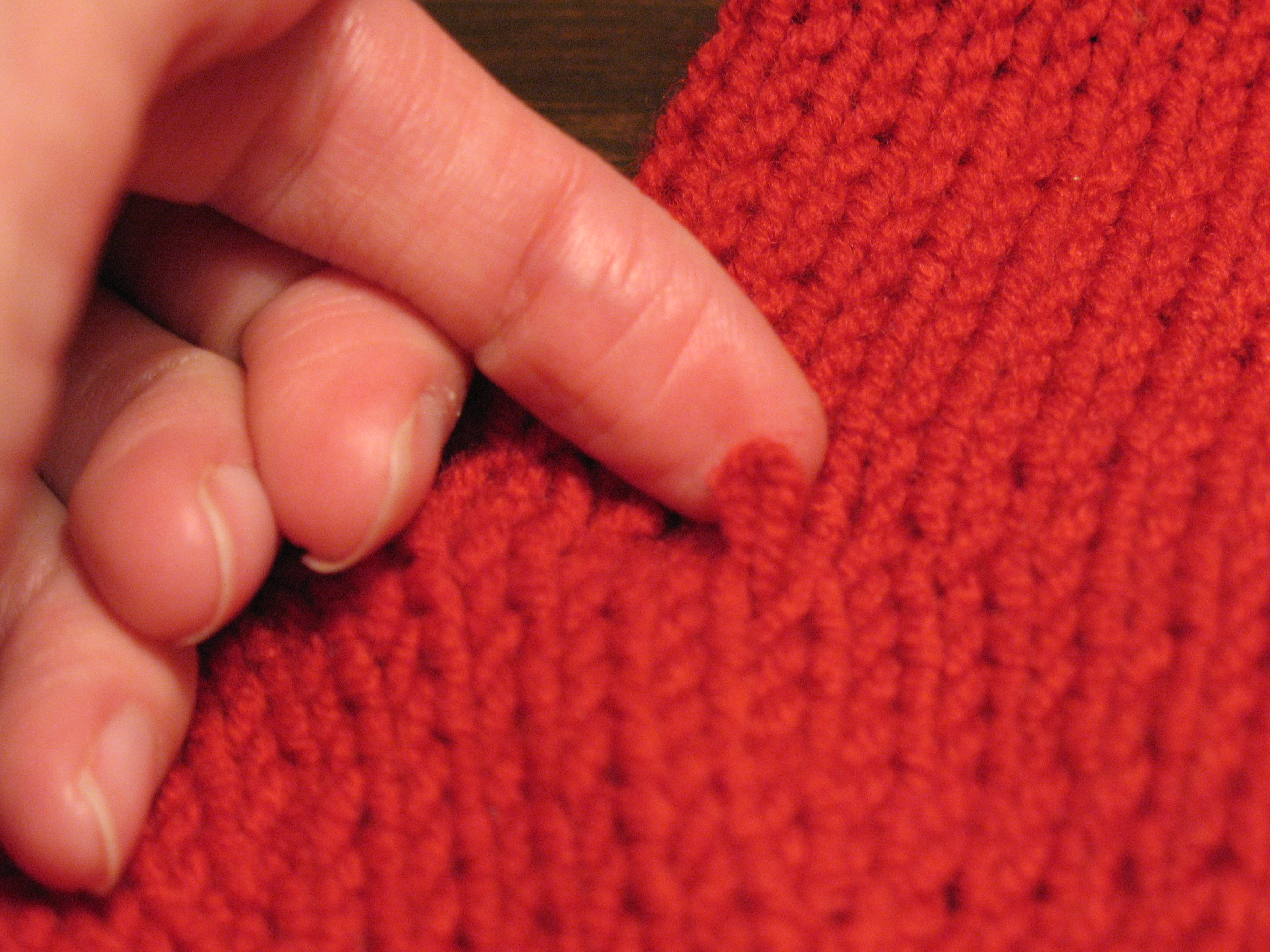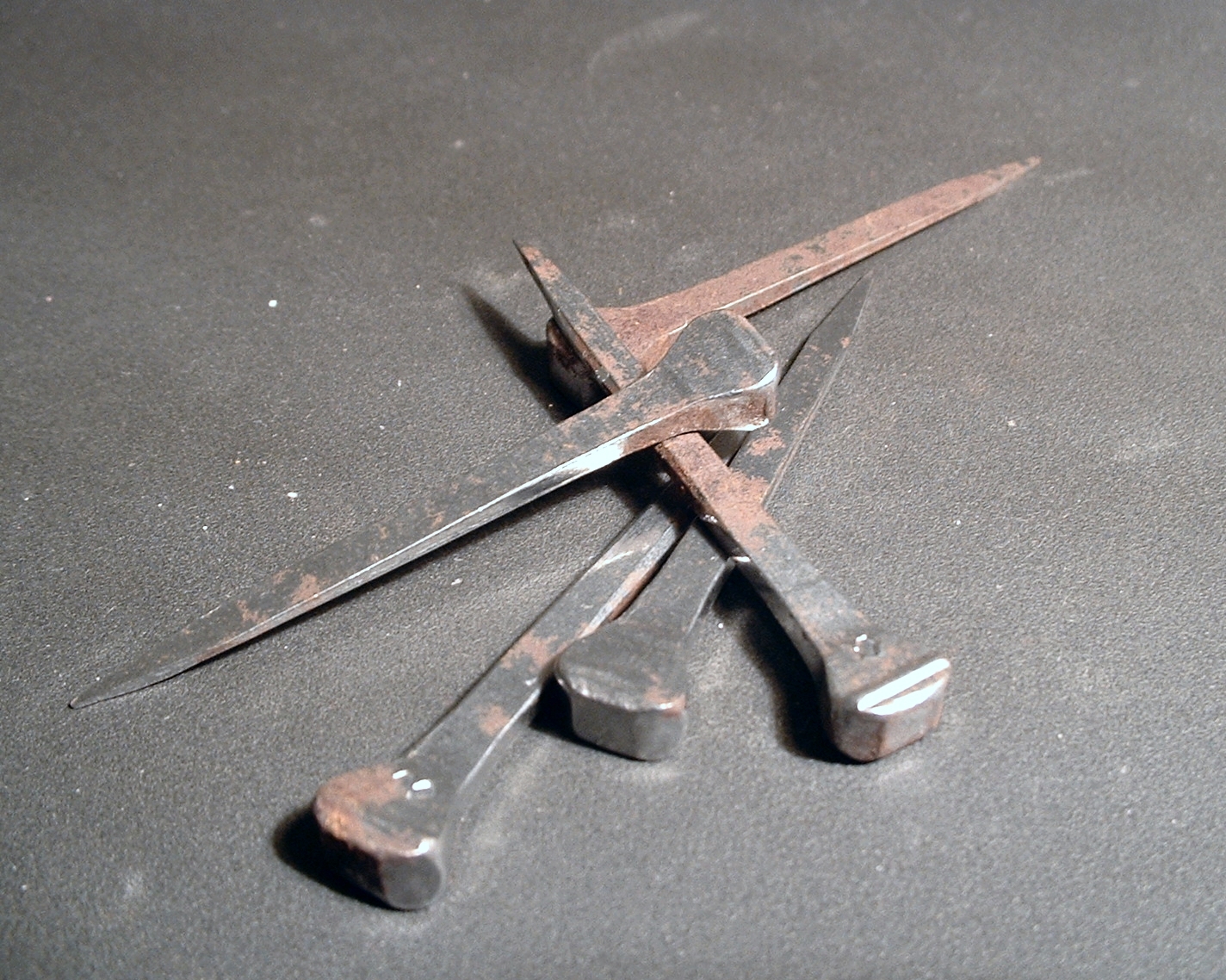|
Spool Knitting
Spool knitting, loom knitting, corking, French knitting, or tomboy knitting is a form of knitting that uses a spool with a number of nails or pegs around the rim to produce a tube or sheet of fabric. The spool knitting devices are called knitting spools, knitting nancys, knitting frame, knitting loom, or French knitters. The technique is to wrap the yarn around all of the spool's pegs, twice. The lower loop of yarn is then lifted over the upper loop and off the peg, thereby creating stitches. The yarn is then wrapped around the entire loom, creating a new upper yarn on each peg. This process is repeated until the project is complete. Spool knitting frames typically have four or five pegs (or brass nails), although the number can range to more than 100. Though not exclusively, the term "loom knitting" often refers to frames with more than those four or five pegs. Uses Many things can be made from the resulting tube. For example, it can be wound in a spiral to produce a mat or ... [...More Info...] [...Related Items...] OR: [Wikipedia] [Google] [Baidu] |
Knitting
Knitting is a method for production of textile Knitted fabric, fabrics by interlacing yarn loops with loops of the same or other yarns. It is used to create many types of garments. Knitting may be done Hand knitting, by hand or Knitting machine, by machine. Knitting creates Stitch (textile arts), stitches: loops of yarn in a row; they can be either on straight flat needles or in ''the round'' on needles with (often times plastic) tubes connected to both ends of the Knitting needle, needles. There are usually many ''active stitches'' on the knitting needle at one time. Knitted fabric consists of a number of consecutive rows of connected loops that intermesh with the next and previous rows. As each row is formed, each newly created loop is pulled through one or more loops from the prior row and placed on the ''gaining needle so'' that the loops from the prior row can be pulled off the other needle without unraveling. Differences in yarn (varying in fibre type, Yarn weight, ''w ... [...More Info...] [...Related Items...] OR: [Wikipedia] [Google] [Baidu] |
Bobbin
A bobbin or spool is a spindle or cylinder, with or without flanges, on which yarn, thread, wire, tape or film is wound. Bobbins are typically found in industrial textile machinery, as well as in sewing machines, fishing reels, tape measures, film rolls, cassette tapes, within electronic and electrical equipment, and for various other applications. Industrial textiles Bobbins are used in spinning, weaving, knitting, sewing, and lacemaking. In these practices, bobbins were invented to "manage the piles of thread and yarn that would be mechanically woven into cloth," which would have originally been wound through the use of human power, but which eventually became machine-driven. In these applications, bobbins provide storage, temporary and permanent, for yarn or thread. Historically, bobbins were made out of natural materials such as wood, or bone. While not in principle an invention of the Victorian era - bobbins in the production of textiles were in earlier use - th ... [...More Info...] [...Related Items...] OR: [Wikipedia] [Google] [Baidu] |
Nail (fastener)
In woodworking and construction, a nail is a small object made of metal (or wood, called a tree nail or "trunnel") which is used as a fastener, as a peg to hang something, or sometimes as a decoration. Generally, nails have a sharp point on one end and a flattened head on the other, but headless nails are available. Nails are made in a great variety of forms for specialized purposes. The most common is a ''wire nail''. Other types of nails include ''pins'', ''Thumbtack, tacks'', ''wikt:brad, brads'', ''spikes'', and ''cleat (shoe), cleats.'' Nails are typically driven into the workpiece by a hammer or nail gun. A nail holds materials together by friction in the axial direction and Shear stress, shear strength laterally. The point of the nail is also sometimes bent over or ''clinched'' after driving to prevent pulling out. History The history of the nail is divided roughly into three distinct periods: * Hand-wrought (forged) nail (pre-history until 19th century) * Cut nail (ro ... [...More Info...] [...Related Items...] OR: [Wikipedia] [Google] [Baidu] |
Reeve 41457
Reeve may refer to: Titles *Reeve (Canada), an elected chief executive of some counties, townships, and equivalents *Reeve (England), an official elected annually by the serfs to supervise lands for a lord *High-reeve, a title taken by some English magistrates during the 10th and 11th centuries *Shire reeve, an official position that originated the term Sheriff *Vogt, an official in many European countries, often translated ''reeve'' Other uses *Reeve (surname), list of notable people with the surname *Reeve, Wisconsin, an unincorporated community *Reeve knot, a stopper knot *Reeve, a female ruff (bird), a wading bird * Reeve (''Final Fantasy''), a character from the video game ''Final Fantasy VII'' *Reeve Electric Association Plant, listed on the National Register of Historic Places in Franklin County, Iowa *"The Reeve's Prologue and Tale", from ''The Canterbury Tales'' by Chaucer * Leander Reeve House, listed on the National Register of Historic Places in Franklin County, Iowa * ... [...More Info...] [...Related Items...] OR: [Wikipedia] [Google] [Baidu] |
Carpet
A carpet is a textile floor covering typically consisting of an upper layer of Pile (textile), pile attached to a backing. The pile was traditionally made from wool, but since the 20th century synthetic fiber, synthetic fibres such as polypropylene, nylon, and polyester have often been used, as these fibres are less expensive than wool. The pile usually consists of twisted Tufting, tufts that are typically heat-treated to maintain their structure. The term ''carpet'' is often used in a similar context to the term rug, but rugs are mostly considered to be smaller than a room and not attached to the floor. Carpets are used for a variety of purposes. These include insulating a person's feet from a cold tile or concrete floor, making a room more comfortable as a place to sit on the floor (e.g., when playing with children or as a prayer rug), reducing sound from walking (particularly in apartment buildings), and adding decoration or colour to a room. Carpets can be made in any colo ... [...More Info...] [...Related Items...] OR: [Wikipedia] [Google] [Baidu] |
Loom
A loom is a device used to weaving, weave cloth and tapestry. The basic purpose of any loom is to hold the Warp (weaving), warp threads under tension (mechanics), tension to facilitate the interweaving of the weft threads. The precise shape of the loom and its mechanics may vary, but the basic function is the same. Etymology and usage The word "loom" derives from the Old English ''geloma'', formed from ''ge-'' (perfective prefix) and ''loma'', a root of unknown origin; the whole word ''geloma'' meant a utensil, tool, or machine of any kind. In 1404 "lome" was used to mean a machine to enable weaving thread into cloth. By 1838 "loom" had gained the additional meaning of a machine for interlacing thread. Components and actions Basic structure File:Simple_treadle_floorloom,_line_drawing.png, upright=1.5, left, A simple treadle floor loom. Mouse over components for pop-up links. The warp runs horizontally. On the left the warp beam, held from turning by with a weighted trough t ... [...More Info...] [...Related Items...] OR: [Wikipedia] [Google] [Baidu] |
Roman Dodecahedra
A Roman dodecahedron or Gallo-Roman dodecahedron is a small hollow object made of copper alloy which has been cast into a regular dodecahedral shape with twelve flat pentagonal faces. Each face has a circular hole of varying diameter in the middle, the holes connecting to the hollow center, and each corner has a protruding knob. Roman dodecahedra date from the 2nd to 4th centuries AD and their purpose remains unknown. They rarely show signs of wear, and do not have any inscribed numbers or letters. Description Roman dodecahedra are cast in metal, usually a copper alloy, although one silver example is known. They are in the shape of regular dodecahedra, with the addition of a small metal ball at each vertex; each face has a circular hole in the centre. The dodecahedra vary in size from 4 to 11 cm; the holes in their faces have diameters ranging from 6 mm to 40 mm. The lightest known example weighs 35 grams; the heaviest 1000 grams. Most are decorated with circles, ... [...More Info...] [...Related Items...] OR: [Wikipedia] [Google] [Baidu] |
Lucet
A lucet is a tool used in cordmaking or braiding which is believed to date back to the Viking and Medieval periods, when it was used to create cords that were used on clothing, or to hang items from the belt. Lucet cord is square, strong, and slightly springy. It closely resembles knitted I-cord or the cord produced on a knitting spool. Lucet may unravel if cut, but is easily fixed with a small knot. Unlike other braiding techniques such as , finger-loop braiding or plaiting, where the threads are of a finite length, lucetted (or knitted) braids can be created without pre-measuring threads and so it is a technique suited for very long cords. Origins of the lucet The supposed Medieval lucets appear to be double-pronged hollow bones, left tubular, presumably so that the cord could be drawn through the centre hole. In contrast, a modern lucet fork is lyre-shaped, normally made of wood, with two prongs at one end and (optionally) a handle on the other. It may also have a hole th ... [...More Info...] [...Related Items...] OR: [Wikipedia] [Google] [Baidu] |
Helix
A helix (; ) is a shape like a cylindrical coil spring or the thread of a machine screw. It is a type of smooth space curve with tangent lines at a constant angle to a fixed axis. Helices are important in biology, as the DNA molecule is formed as two intertwined helices, and many proteins have helical substructures, known as alpha helices. The word ''helix'' comes from the Greek word , "twisted, curved". A "filled-in" helix – for example, a "spiral" (helical) ramp – is a surface called a '' helicoid''. Properties and types The pitch of a helix is the height of one complete helix turn, measured parallel to the axis of the helix. A double helix consists of two (typically congruent) helices with the same axis, differing by a translation along the axis. A circular helix (i.e. one with constant radius) has constant band curvature and constant torsion. The slope of a circular helix is commonly defined as the ratio of the circumference of the circular cylinder that it ... [...More Info...] [...Related Items...] OR: [Wikipedia] [Google] [Baidu] |
Lucet
A lucet is a tool used in cordmaking or braiding which is believed to date back to the Viking and Medieval periods, when it was used to create cords that were used on clothing, or to hang items from the belt. Lucet cord is square, strong, and slightly springy. It closely resembles knitted I-cord or the cord produced on a knitting spool. Lucet may unravel if cut, but is easily fixed with a small knot. Unlike other braiding techniques such as , finger-loop braiding or plaiting, where the threads are of a finite length, lucetted (or knitted) braids can be created without pre-measuring threads and so it is a technique suited for very long cords. Origins of the lucet The supposed Medieval lucets appear to be double-pronged hollow bones, left tubular, presumably so that the cord could be drawn through the centre hole. In contrast, a modern lucet fork is lyre-shaped, normally made of wood, with two prongs at one end and (optionally) a handle on the other. It may also have a hole th ... [...More Info...] [...Related Items...] OR: [Wikipedia] [Google] [Baidu] |





